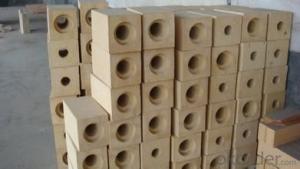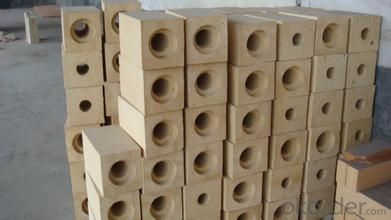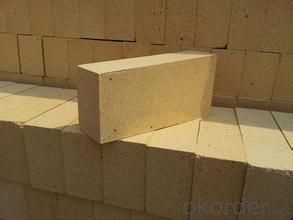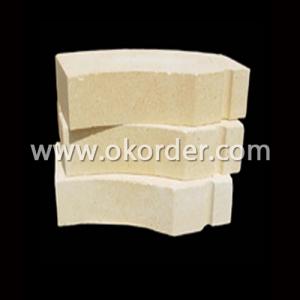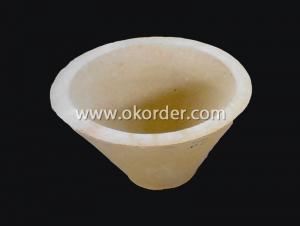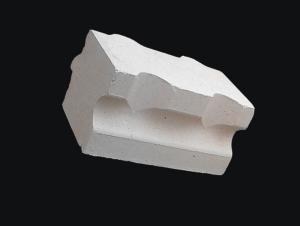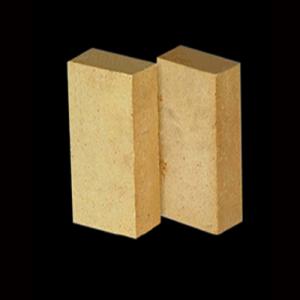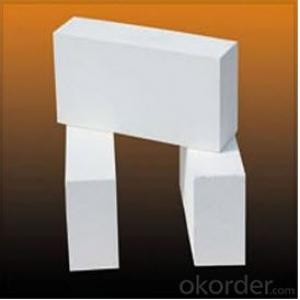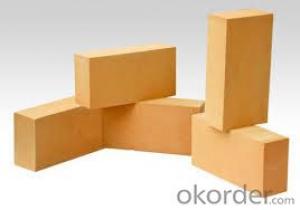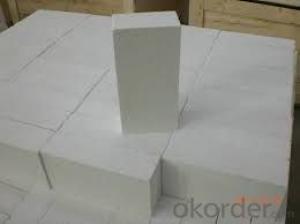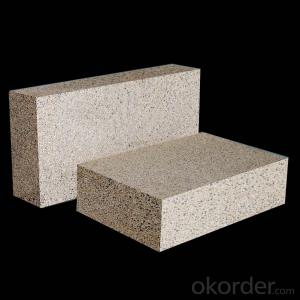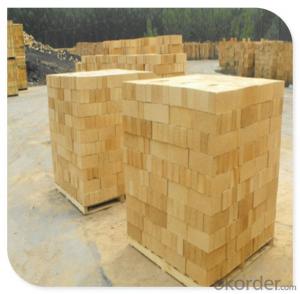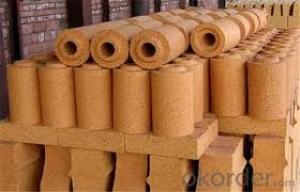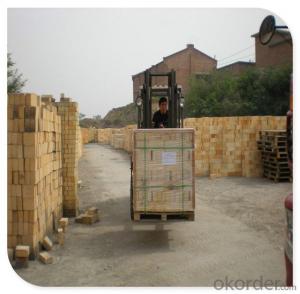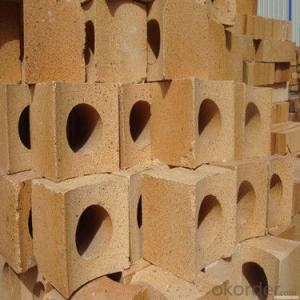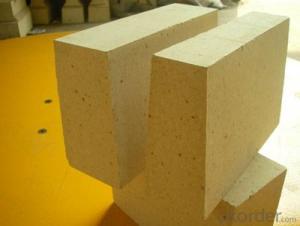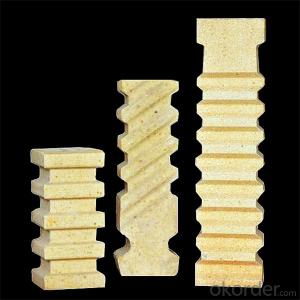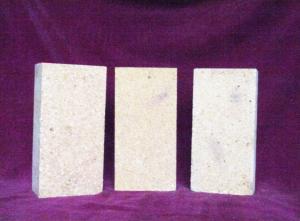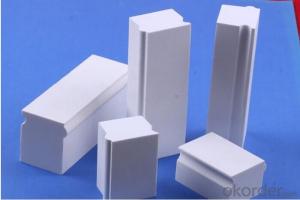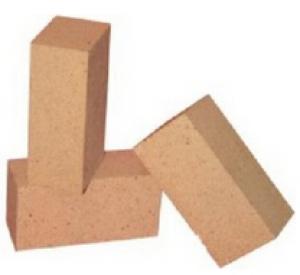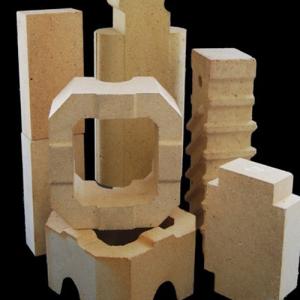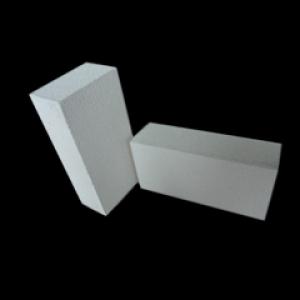High Alumina Brick - Good Price High Alumina Refractory Brick
- Loading Port:
- China main port
- Payment Terms:
- TT OR LC
- Min Order Qty:
- 25 m.t.
- Supply Capability:
- 2000 m.t./month
OKorder Service Pledge
OKorder Financial Service
You Might Also Like
Raw material: Natural ore and its extract or other synthetic materials.
Refractory brick features:
1.Export more than 20 countries;
2.Accurate delivery time;
3.Professional technical service;
4.Most bricks in stock.
Refractory brick Process:
Raw material to factory→ checkout→ burdening→stirring→mixing→taking out the raw material→transfer
→enter into mould→press machine extrusion→going out the mould→stoving→going into the furnace→firing
→stopping burn→cooling→open the furnace door→going out the furnace→checkout→packing→qualified product
→putting in storage→sale
| High Alumina Refractory Brick Physical and Chemical Index : | ||||||
| Item | Properties | |||||
| LZ-80 | LZ-75 | LZ-65 | LZ-55 | LZ-48 | ||
| Al2O3 (%) | 80 | ≥75 | ≥65 | ≥55 | ≥48 | |
| Refractoriness (°C ) | ≥1790 | ≥1790 | ≥1790 | ≥1770 | ≥1750 | |
| Bulk density (g/cm3) | 2.65 | 2.5 | 2.45 | 2.4 | 2.3 | |
| Softening temperature under load (°C ) | 1530 | ≥1520 | ≥1500 | ≥1470 | ≥1420 | |
| Linear changes on reheating (%) | 1500°CX2H | 0.1 | 0.1 | 0.1 | 0.1 | |
| -0.4 | -0.4 | -0.4 | -0.4 | |||
| 1450°CX2H | 0.1 | |||||
| -0.4 | ||||||
| Apparent porosity (%) | 22 | ≤23 | ≤23 | ≤22 | ≤22 | |
| Cold crushing strength (Mpa) | 55 | ≥50 | ≥45 | ≥40 | ≥35 | |
| Application | steel furnace, glass furnace, sodium silicate furnace, ceramic shuttle kiln, cement rotary kiln, blast furnace, electric furnace, blast furnace and reverberatory furnace. | |||||
Other Refractory Product:
| Item | Product | Reference Index | Application |
| 1 | Fire Clay Brick | 1.Al2O3:30-48%; 2.Refractoriness:1580-1750°C; 3.Refractoriness under load:1300-1400°C; 4.Bulk density:2.0-2.2g/cm3. | 1.Glass furnace, 2.Heating furnace, 3.Hot blast stove, 4.Blast furnace, 5.Metal melting furnace, 6.Bolier, 7.Pizza oven, 8.All industrial furnace. |
| 2 | Low Porosity Fire Clay Brick | 1.Al2O3:41-45%; 2.Refractoriness:≥1750°C; 3.Refractoriness under load:>1500°C; 4.Bulk density:2.3-2.37g/cm3; 5.Apparent porosity:12-15% | 1.Glass industry, 2.Steel industry, 3.Chemical industry. |
| 3 | High Alumina Brick | 1.Al2O3:48-80%; 2.Refractoriness:≥1790°C; 3.Refractoriness under load:1300-1400°C; 4.Bulk density:2.3-2.65g/cm3. | 1.Glass furnace, 2.Heating furnace, 3.Heat treatment furnace, 4.Blast furnace, 5.Metal melting furnace, 6.Electric furnace, 7.Pizza oven, 8.All industrial furnace. |
| 4 | Fused Cast Zirconia Corundum Block | 1.Al2O3:40-50%; 2.ZrO2:32-41%; 3.SiO2:13-17%; 4.Exudation temperature of glass phase: 1080-1400°C; 5.Refractoriness under load:1400-1450°C; 4.Bulk density:3.4-3.95g/cm3. | 1.Flat glass furnace, 2.Glass tube furnace, 3.Float glass furnace, 4.Glass bottle furnace, 5.Sodium silicate furnace, 6.Ceramic frit furnace, 7.Glass melting furnace. |
| 5 | Sintered Azs Refractory Brick | 1.ZrO2:18-30%; 2.Al2O3:48-70%; 2.Refractoriness:1770-1790°C; 3.Refractoriness under load:1600-1680°C; 4.Bulk density:2.8-3.4g/cm3. | 1.Glass furnace, 2.Sodium silicate furnace, 3.Ceramic Frit furnace, 4.Metallurgical furnace. |
| 6 | Sintered Zircon Firebrick | 1.ZrO2:64%; 2.SiO2:34%; 2.Refractoriness:1790°C; 3.Refractoriness under load:1620°C; 4.Bulk density:3.5-3.7g/cm3. | 1.Glass furnace, 2.Sodium silicate furnace, 3.Ceramic Frit furnace, 4.Metallurgical furnace. |
| 7 | Sintered Zirconia-mullite Brick | 1.ZrO2:18-25%; 2.Al2O3:60-67%; 2.Refractoriness:1790°C; 3.Refractoriness under load:1650°C; 4.Bulk density:2.9-3.0g/cm3. | 1.Glass furnace, 2.Sodium silicate furnace, 3.Ceramic Frit furnace, 4.Ladle lining. |
| 8 | Sillimanite Refractory Brick | 1.Al2O3:>60%; 2.SiO2:37%; 3.Refractoriness:1790°C; 4.Refractoriness under load:1450-1510°C; 5.Bulk density:2.2-2.4g/cm3. | 1.Glass furnace, 2.Float glass furnace, 3.Feeding machine, 4.Drawing machine. |
| 9 | Sintered Mullite Fire Brick | 1.Al2O3:64-80%; 2.Fe2O3:0.5-1.2%; 3.Refractoriness:1790°C-1810°C; 4.Refractoriness under load:1560-1700°C; 5.Bulk density:2.45--2.75g/cm3 | 1.Glass furnace, 2.Float glass furnace, 3.Feeding machine, 4.Drawing machine. |
| 10 | Silica Brick | 1.SiO2:95-96%; 2.Refractoriness:1710°C; 3.Refractoriness under load:1650-1680°C; 4.Bulk density:1.85-1.9g/cm3. | 1.Glass furnace, 2.Coke oven, 3.Hot blast stove. |
| 11 | Magnesia Fire Brick | 1.MgO:92-97%; 2.CaO:2-2.5%; 3.SiO2:1-4%; 4.Refractoriness under load:1600-1700°C; 5.Bulk density:2.88-3.0g/cm3. | 1.Glass Furnace, 2.Cement kiln, 3.Metallurgical furnace, 4.Steel making electric furnace 5.Flat furnace. |
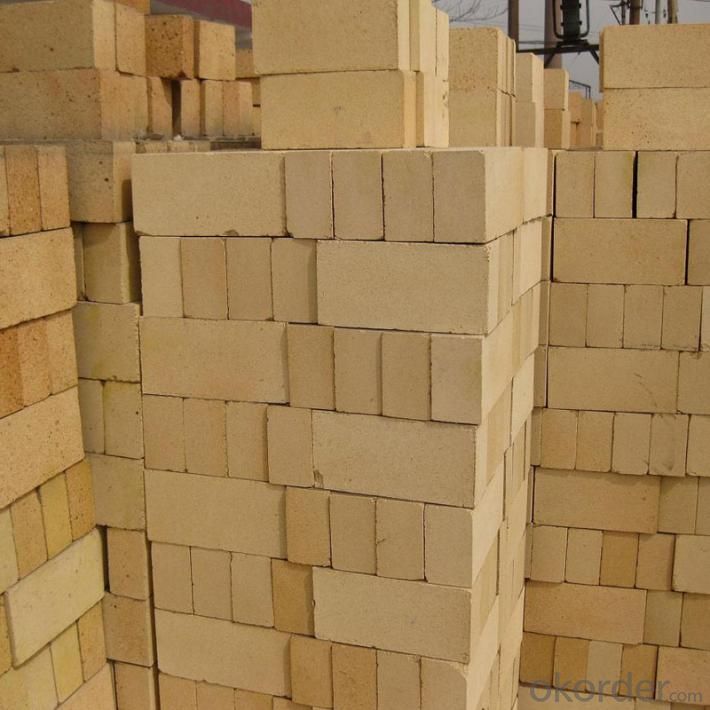
- Q: Is there a big difference between two high alumina brick and one high alumina brick?
- The difference between the two kinds of high alumina bricks is great. I perennial in Zhengzhou was responsible for the production and sale of colt refractories
- Q: Introduction of high alumina brick
- Three alumina silicate refractory product with a content of two Al2O3 (48%).
- Q: What is the price of the latest thermal insulation material?
- Also through online pre understand the products and prices, and now have large-scale manufacturers are generally opened on the cable business. Goods than three, manufacturers on-site inspection, confirm the quality of goods after considering cooperation.
- Q: What are the specific raw materials for plastic pallets?
- There are two kinds of raw materials for plastic pallets: one is polypropylene (PP) and the other is polyethylene (HDPE).Plastic pallets for logistics storage: pp+pe material, recycled material 10%;Plastic trays for food trays: food grade PP, PE, pc;Polyethylene (HDPE) has excellent impact resistance and cold resistance, and it can resist environmental stress cracking. Excellent chemical stability, good oil resistance. Water absorption and tiny, low permeability, organic vapor transmission rate is larger. Electrical insulation is good, in all frequency range, dielectric properties are extremely excellent.
- Q: What's the difference between a well type annealing furnace and a box type annealing furnace?
- RT3 series trolley type resistance furnace is a national standard energy-saving cycle type operation furnace. It has super energy-saving structure, adopts fiber structure and saves electricity 30%. Exclusive production of composite high aluminum nails group, car anti-collision sealing brick, automatic sealing trolley and furnace door, integrated rail, without the basic installation, placed on the ground floor can be used. Mainly used for high chromium, high manganese steel castings, ductile iron, roller, steel ball, 45 steel, stainless steel quenching, annealing, aging, and various mechanical parts heat treatment. Features: 1, no noise, no environmental pollution. 2, small heat storage, less heat loss. 3, high temperature control accuracy, furnace temperature uniformity. 4, a high degree of automation, simple. 5, PID programming can be used to set, fully automatic operation. 6, good sealing, long life, safe and reliable. Widely used in chemical, petroleum, food, metallurgy, machinery, light industry, electricity, ships, paper, mining, medicine, central heating and other industrial sectors. With the development of social productive forces, its application in various industries is more and more widespread. Two, pitannealingfurnace (for example: flange heat treatment furnace) use: the furnace for metal parts, such as ring of equipment heat treatment at rated temperature: the furnace is composed of furnace body and a movable furnace cover and control system.
- Q: How are the high alumina bricks fired?
- Light and high alumina bricks are usually fired in a weak oxidizing atmosphere. In light and high alumina bricks firing, they are often rich in impurities such as R2O, RO, Fe2O3 and so on. They react with Al2O3 and SiO2 at high temperature to produce liquid phase. In the Al2O3 - SiO2 - R2O system, the growth rate of liquid phase increases with the increase of temperature at high temperature. So, because the increase of sintering temperature brings a lot of liquid phase, the decrease of liquid viscosity will lead to the deformation of brick and the decline of brick high temperature function. Therefore, the lower sintering temperature and longer holding time should be adopted in the sintering process dominated by liquid phase sintering. The production practice shows that the same firing temperature can be used for the high grade aluminum bricks. When fired in an inverted flame kiln, it is usually 1430 degrees centigrade and insulated by 40H. The high alumina bricks such as Ill are 1390~1420 degrees centigrade. When the tunnel kiln is fired, they are 1550 and 1450~1500 degrees centigrade respectively. High alumina brick is usually made of weak oxidizing atmosphere.
- Q: What are the alloy wear resistance materials?
- According to the composition of Beijing Naimo metal materials company will wear resistant metal materials is divided into the following five categories: one: high manganese steel series: high manganese steel (ZGMn13),
- Q: The difference between light high alumina brick and heavy aluminum brick
- Lightweight high alumina brick, also called high alumina insulation brick. Alumina content of 48% or more, mainly from mullite and glass phase or corundum composition of lightweight refractory. Volume density 0.4 - 1.35g/cm3. Porosity 66% - 73%, compressive strength 1 - 8MPa. Better thermal shock resistance. Usually, a high alumina clinker is added with a small amount of clay. After grinding, it is poured and shaped in the form of slurry by gas generation or foam method, and it is fired at 1300 - 1500 DEG C. Sometimes industrial alumina can be used instead of some bauxite clinker. Used for lining and insulation of masonry kilns, as well as for areas where there is no strong, high temperature molten material erosion and erosion. When contacting the flame directly, the surface contact temperature shall not be higher than 1350 degrees centigrade.
- Q: What's the weight of the refractory bricks?
- Referred to as refractory brick. Refractory made from refractory clay or other refractory material. Light yellow or brownish. The utility model is mainly used for laying smelting furnaces, and can withstand high temperature between 1580 DEG C and 1770 DEG C. Also called brick. Refractory material of a certain shape and size. According to the preparation process can be divided into bricks, brick, electric melting brick, refractory insulating bricks (Rong Zhuzhuan);
- Q: The difference between clay bricks and clay bricks
- Sintering bricks do not have clay bricks, so sintering bricks are made of stone. Clay brick is clay cooking, two yo, qualitative difference, but the appearance and color almost, but the quality is very different, life expectancy is also a great gap.
Send your message to us
High Alumina Brick - Good Price High Alumina Refractory Brick
- Loading Port:
- China main port
- Payment Terms:
- TT OR LC
- Min Order Qty:
- 25 m.t.
- Supply Capability:
- 2000 m.t./month
OKorder Service Pledge
OKorder Financial Service
Similar products
Hot products
Hot Searches
Related keywords
